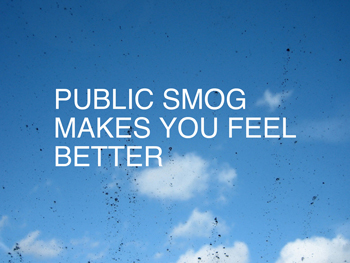 Public Smog Public Smog
Amy Balkin
Public Smog is a park in the atmosphere that fluctuates in location and scale. The park is constructed through financial, legal, or political activities that open it for public use.
Activities to create the park have included purchasing and retiring emission offsets in regulated emissions markets, making them inaccessible to polluting industries.
When Public Smog is built through this process, it exists in the unfixed public airspace above the region where offsets are purchased and withheld from use. The park's size varies, reflecting the amount of emissions allowances purchased and the length of contract, compounded by seasonal fluctuations in air quality.
Public Smog opened over California's South Coast Air Quality Management District in 2004, and over the European Union in 2007.
Other activities to create Public Smog impact the size, location, and duration of the park. These activities include an attempt to submit Earth's atmosphere for inscription on UNESCO's World Heritage List.
Public Smog is subject to prevailing winds, and the long-range transport of aerosols and gases.
|
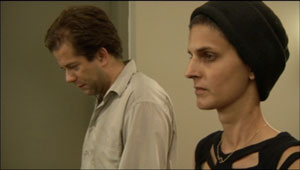 The Cost of Life The Cost of Life
Beatriz da Costa
The Cost of Life examines the ethical, emotional, and economic costs of producing and sustaining life. The Cost of Life consists of a series of projects spanning different media. The first "Dying for the Other," is a video triptych addressing a situation of shared suffering, involving mice used in breast cancer research, and humans afflicted with the same disease. In order to produce this video, da Costa documented scenes of her own life during the summer of 2011 and combined them with footage taken at a breast cancer research facility in New York City over the same time span. "Dying for the Other," is being exhibited for the first time as part of EcoCultures.
A second project currently in development is the "Life Garden," consisting of a medicinal "anti-cancer" garden, a performative lecture, and cooking event.
Supported by the Creative Capital Foundation and Eyebeam.
|
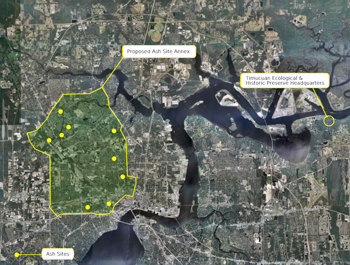 Contaminating the Preserve Contaminating the Preserve
Ryan Griffis, for The Temporary Travel Office
In the early to mid 1990s, several sites were "discovered" that were once waste incinerators and dumps used by the City of Jacksonville from the late 19th century into the 1960s. 9 of these ash-related sites are in the same general vicinity of Northwest Jacksonville, adding up to more than 321 acres of ash contaminated land. These incinerators burned all manner of solid waste, producing ash containing lead, arsenic, dioxin, PCBs, mercury, and pesticide compounds. This ash material became airborne, drifting in, and beyond, the mostly African-American neighborhoods where the incineration occurred.
The Temporary Travel Office proposes an Ash Site Annex (ASA) to the nearby Timucuan Ecological and Historic Preserve that would introduce this more recent urban context to the Preserve's narratives of history and environmental awareness. The ASA takes a cue from the Preserve's celebration of the "Timucuan Indian" cultures of Northeast Florida - referred to as "People of the Shell Mounds." This nickname is derived from the vast amounts of shellfish remains they left along the river we call the St. Johns. The Timucua were extinct by the middle of the 18th century - two hundred years of colonial wars and introduced disease effectively decimated the tens of thousands that existed at the time of European contact. As the National Park Service states:
"The lesson to be learned from the existence and disappearance of the Timucuan people is that in a clash of cultures ultimately one group, no matter how advanced or well established, may vanish."
In essence, the ASA asks: If Jacksonville's current residents were to vanish, what kinds of stories would we be found in our trash? What kinds of mounds would we be the "People of"? And, what kind of "clash of cultures" would be found?
|
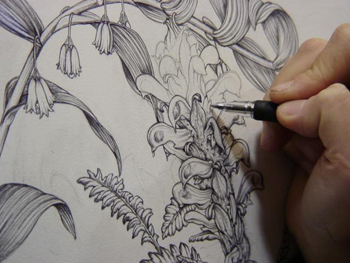 The True Cost of Coal: Mountaintop Removal and the Fight for Our Future
The True Cost of Coal: Mountaintop Removal and the Fight for Our Future
Beehive Design Collective
Mountaintop Removal and the Struggle for Justice in Appalachia. In 2008, the Beehive Design Collective allied with Appalachian grassroots organizers fighting Mountain Top Removal Coal Mining, a highly destructive practice that blasts ancient mountains into toxic moonscapes to fuel the ever-growing global demand for electricity. This graphic reflects the complexity of the struggles for land, livelihood, and self-determination playing out in Appalachia, while honoring the tremendous history of organized resistance and the courage of communities living in the shadow of Big Coal.
The project strives to help more people understand the true cost of our national energy choices and how we are all connected to this issue. This graphic also looks to the future, raising questions about resistance, regeneration, and remediation. The True Costs of Coal challenges all of us who casually flip on a light switch to examine our own connections to
mountaintop removal- and to think about what we can do to stop it from within our own communities.
|
 Children of Sodom and Gomorrah
Children of Sodom and Gomorrah
Jens Jarisch & Sharon Davis
Sodom and Gomorrah is a hellish place in Accra, Ghana where children eke out a living on a scrap heap of discarded computers that The West no longer needs. They sell the computer parts but the toxic chemicals in the waste are slowly poisoning the children. They dream of escaping illegally to Europe to live like the people whose computers they are harvesting. Producer Jens Jarisch went to Sodom and Gomorrah and then followed some of the children on their treacherous journey across Africa. He also followed the e-waste on its journey from the the docks in Germany to a place that's out of sight and out of mind.
The adaptation of the German programme was realised by Sharon Davis and Russell Stapleton with narration by Rebecca Massey and additional performances from Josef Ber and Thuso Lekwape, and is presented by Brent Clough. |
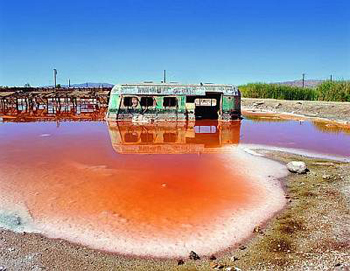 Greetings from the Salton Sea
Greetings from the Salton Sea
Kim Stringfellow
The Salton Sea is a man-made catastrophe, redolent with the smell of algae and decomposing fish. Nevertheless, the lake's vast, placid expanses continue to attract birdwatchers, tourists and artists. In Greetings from the Salton Sea, photographer Kim Stringfellow explores the history of California's largest lake from its disastrous beginnings—the "sea" was formed when Colorado River levees broke and spilled into a depression 280 feet below sea level—to its heyday as a desert paradise in the 1950s and its current state as an environmental battleground.
Like the 400-plus species of birds that use the lake as a halfway point in their annual migration, developers flocked to the water too: they planted palm trees, built golf courses, and hired showstoppers such as the Beach Boys to perform at area resorts. These days, politicians seek to redirect the lake's only source of replenishment—agricultural runoff from surrounding farms—to water golf courses and green lawns elsewhere. Greetings from the Salton Sea's photographs capture the war among policymakers, environmentalists, developers, and the individuals still living along the lake's shores. As Stringfellow aptly documents, it is a war for water and, ultimately, for existence.
|
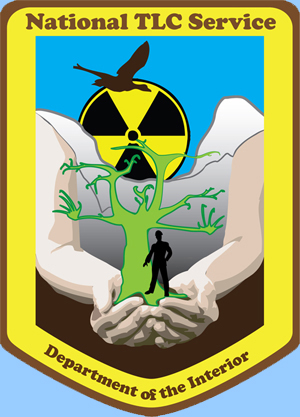 National Toxic Land/Labor Conservation Service National Toxic Land/Labor Conservation Service
Sarah Kanouse & Shiloh Krupar
The National TLC Service is a wishful federal agency within the Department of the Interior charged with developing cultural programs that address issues of environmental justice, labor, and human rights related to US military activities. It works in collaboration with the grassroots organizations and affected individuals already involved in contesting and reforming the DOE, DOD, and DOI's land and legacy stewardship practices.
|
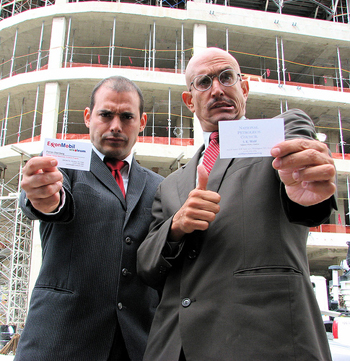 Chamber of Commerce Goes Green
Chamber of Commerce Goes Green
Yes Lab
The action that gave birth to the Yes Lab.
Shortly after launching a battalion of Survivaballs at the United Nations in the fall of 2009 to urge action against climate catastrophe, we heard from a group of activists in Washington, D.C., the Avaaz Climate Action Factory, who drew our attention to Public Enemy #1 of sane climate policy: the U.S. Chamber of Commerce.
While the Chamber often flies under the radar, in recent years it has become more visible by launching multi-million-dollar advertising campaigns and lobbying blitzes to derail a sensible climate bill in the Senate (not to mention spending hundres of millions to oppose health care reform, employee free choice and even pushing to kill sensible banking regulations that could thwart another economic meltdown). With the fate of the Senate climate bill very much up in the air, and only months to go before a major UN conference on climate that the Chamber was furiously trying to derail, our Action Factory friends felt that these people needed to be unmasked, and quick.
Lo and behold, a mere one week later, the U.S. Chamber of Commerce surprised everyone with a dramatic announcement at the National Press Club, reversing its position on climate change policy, and promising to immediately cease lobbying against the Kerry-Boxer bill, the leading piece of legislation in the U.S. Senate meant to reduce CO2 emissions.
Not.
Within minutes of the Chamber's announcement, it was dramatically and comically revealed that the "Chamber spokesperson" was an impostor, and the press conference an elaborate hoax to draw attention to the Chamber's backward position. For this we have to give thanks to Eric Wohlschlegel, the visibly rattled Chamber of Commerce spokesperson who barged into the room and declared the event a fraud. In the ensuing stand-off, both Wohlschlegel and "Hingo Sembra" (our Chamber rep.) accused the other of being a fraud. "Can I see your business card?" Wohlschlegal demanded of his doppleganger. "Can I see yours?" parried Sembra. After an extended impasse in the battle of the business cards, Wohlschlegel beat a hasty retreat, handing every journalist he could collar a business card.
The Action Factory and Yes Men ruse was covered by media around the world, putting the Chamber's greedy and destructive influence on our politics in the spotlight. As for the Yes Men, besides being named plaintiffs in a lawsuit against them and "John and Jane Doe 1-20," it was the collaborative nature of the project—developing and executing an amazing plan over the course of three or four days—that left us inspired and ready to think big. That desire led us on to other amazing collaborations, and ultimately the launch of the Yes Lab itself.
|
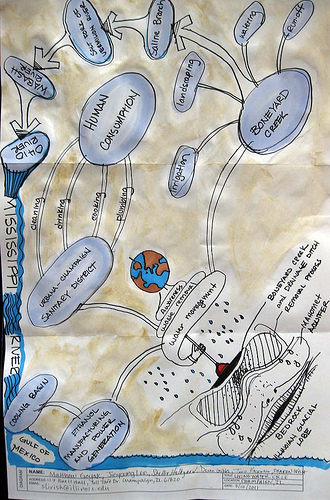
A Map Without Boundaries
Matthew Friday & Jeff Lovett
A Map Without Boundaries is a mail art project published by Regional Relationships. The project contains diagrams of the Appalachian watershed system as well as paper, pen, brush and a pigment derived from Ohio’s abandoned mines. These tools, along with the accompanying diagrams can be used to visualize nature/culture entanglements in other regions. These diagrams will be collected as part of an ongoing archive to be include in future exhibitions. The tube of paint included in this kit was produced using an experimental water treatment technique developed by Dr. Guy Riefler, an environmental engineer from Ohio University. Using local labor and sustainable energy sources, acid mine drainage is turned into a functional artistic and industrial pigment. The diagrams produced for this project were part of a collaboration with spurse, a design and consultancy collective.
|
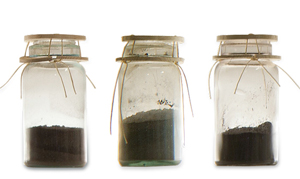
Shoemaker's Dialogues
Futurefarmers
From May 4 -14, 2011, Futurefarmers created a nine-day "urban thinkery" centered around a shoemaker's atelier consisting of a cobbler's bench and shoes installed in the Guggenheim Museum's Rotunda in New York. The atelier was an open interpretation of Simon the Shoemaker's Fifth-century Athens studio in which Socrates allegedly had extensive philosophical discussions with Simon and local youth. Building on the idea of Simon as a living example of a form of knowledge analogous to the what Socrates was searching for (namely the art of taking care of one's soul) Futurefarmers hosted intimate public dialogs with a labor historian, anthropologist, geologist and environmental scientists. In between and after these discussions, Futurefarmers performed ink gathering excursions in different parts of New York.The "soot" collected from the ink gathering excursions were mixed with honey and eggs harvested from New York City rooftop hives and gardens to form ink used to print the Soul/Sole Sermons with a public print-making intervention entitled, the Pedestrian Press. |
|











